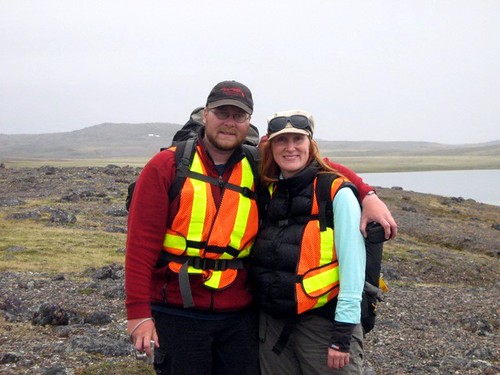Elfshot Sticks and Stones in St Johns

 Tim Rast is a thirty four year old archaeologist and ‘flintknapper’ from St Johns Newfoundland that blogs bits of his daily business into beautiful bundles of archeological ‘infotainment’. He details himself and his existence by relating anecdotes every Monday, Wednesday and Friday. His canny observations and candor make his writing as fascinating as his scholarly career.
Tim Rast is a thirty four year old archaeologist and ‘flintknapper’ from St Johns Newfoundland that blogs bits of his daily business into beautiful bundles of archeological ‘infotainment’. He details himself and his existence by relating anecdotes every Monday, Wednesday and Friday. His canny observations and candor make his writing as fascinating as his scholarly career.
Elfshot: Sticks and Stones chronicles the existence of a 21st century flintknapper, a man who makes stone arrowheads for a living. Many hundreds of years ago this skill was in high demand, and so too were the handcrafted points on the arrows made by the Maritime Archaic Indians, the Groswater and Dorset Palaeoeskimo and the Newfoundland Recent Indians. But those days are long past, and now the market has dried up. Only a very few exceptional humans eek out a living as flintknappers today.
Knapping (def.): Knapping is the shaping of flint, chert, obsidian or other stone through the process of lithic reduction to manufacture stone tools, strikers for flintlock firearms, or to produce flat-faced stones for building or facing walls, and flushwork decoration.
 Is it a coincidence that Tim’s Elfshot Gallery enterprise uses the same font as Flintknappers.com? There is some connection here although Tim doesn’t maintain a profile on this infamous flintknappers site, he must count the domain as an influence on his own Elfshot gallery creation.
Is it a coincidence that Tim’s Elfshot Gallery enterprise uses the same font as Flintknappers.com? There is some connection here although Tim doesn’t maintain a profile on this infamous flintknappers site, he must count the domain as an influence on his own Elfshot gallery creation.
Tim Rast is a great writer that’s just masquerading as an archeology blogger. His September 25th 2009 post, I grew Up in Vulcan was my first taste of his work. After the first two paragraphs I was hooked, and I spent the rest of that day reading his prose. His writing reminds me of James Michener ( esp the novel Centennial) and I personally love Tim’s easy going attitude; in another recent post he describes how his car was broken into, and his parking change stolen, but his CDs were still in the glove box. “I guess thieves don’t steal CDs anymore” In the same piece of writing he goes on to relate other details of his day, and the tragedy of his tarnished automobile is soon forgotten. The robbery was inconsequential as indeed it would be to someone with such passion for creating things.
You can tell by his diction and references that this blogger is well read, and has a good education. More research reveals that Tim earned his Bachelor of Science in Archaeology at the University of Calgary in 1996, and followed that with a Masters Degree in Anthropology from Memorial University of Newfoundland in 1999. Currently he volunteers with the Craft Council of Newfoundland and Labrador and sits on the Board. Despite all his schooling and exposure to blogs in academia, it was influences in this arts council that finally put him to blogging.

“…at the time I was on the executive with the Craft Council of Newfoundland and Labrador and we had hired an Internet consultant to help us with the web presence of the Craft Council and its members. Blogging emerged from that process as a quick easy way to manage all of the various online content related to a craftsperson’s career. I went home after a particularly inspirational meeting with the consultant Wilma Hartmann and started a blog.”
Tim Rast has been actively blogging ever since, using the blogspot platform as a companion for his Elshot.com information and photo gallery. This is smart combination, and so is the author’s approach to the discipline; Tim is a jogger, and a blogger. He schedules running and blogging in equal portions in his weekly routine; one exercises his body and the other works muscles in his brain. Tim ran his 1st 10-mile road race this July, and he’ll be participating in the St John’s Run For the Cure on Oct 4th. He’ll be blogging about it on the 5th.
Elfshot: Sticks and Stones helps Tim promote his work and create an online portfolio of past projects. He writes that, “A lot of what I do when I’m working on an artifact reproduction is trial and error, and so the blog is one way of keeping a record of what works and what doesn’t work.”. He confirms that “Blogging is a great way to generate fresh content and keep people informed on what’s going on with my business.”
 “Sometimes I have difficulty explaining what I do, but blogging gives me an opportunity to show and tell people how I make a living.”
“Sometimes I have difficulty explaining what I do, but blogging gives me an opportunity to show and tell people how I make a living.”
As an undergraduate at the University of Calgary, Tim had the opportunity to work in some of Canada’s most northern archeological sites, and he found the experience “life changing”. He writes, “The archaeology of the North is phenomenal. People have been doing so much more there than just surviving for thousands of years. The artistic details and skill that went into crafting everyday objects is awe-inspiring.”
When I asked him to select his favourite posts, he replied with five links; “I like this one about Dorset Palaeoeskimo knives as it’s a pretty good little snapshot of what the site is, and what Elfshot is all about. It brings archaeology, craft, and the Arctic all together, with a pinch of polar bears.”
 “The patinating copper post is one that I’m fond of and it gets a lot of traffic. Its a fun bit of household chemistry that’s useful to me for the sort of artifact reproduction work that I do and evidently other people are interested in how to turn copper green.”
“The patinating copper post is one that I’m fond of and it gets a lot of traffic. Its a fun bit of household chemistry that’s useful to me for the sort of artifact reproduction work that I do and evidently other people are interested in how to turn copper green.”
“Lori’s posts are always popular. Here’s one from her birthday that describes Lori’s awesome powers over seals.”
“The first post about the Tuktut Nogait bow that I’m working on for Parks Canada (and myself) is a current favourite. It’s exactly the sort of work that I love doing, and at the same time I had family visiting and they were able to participate. It’s so hard to describe to my family what I do and on this particular day I think they really understood how I make a living.”
“The Ioffe Site post is about an archaeology site that we found while I was working as a resource archaeologist for an Adventure Canada cruise last fall. I have such fond memories of that trip and this was a post that I put together for everyone I traveled with.”
“In June, I helped out with a short documentary on one of Newfoundland’s most amazing archaeological sites. It was a unique experience and it’s of interest here because I was contacted for the work by a film maker who knew I could talk about stone tools because he was following my blog.”

But blogging has gotten Tim into trouble too…
“In one instance, in the middle of an unrelated post, I spoke a little too openly about some of the details of our mortgage refinancing. My lawyer (who is also a friend who reads the blog) advised me to be cautious about that sort of thing. That’s the only time I edited a blog post for a reason other than spelling or grammar. Personally, I think its kind of cool that I had to remove something on advice from my lawyer – it makes me feel like Hunter Thompson, but Lori doesn’t like that I draw any attention to it at all.”
And, “then there was also the one where I talked about Lori’s dad taking a pressure washer to his truck engine. Lori didn’t like that it made her dad look like a goof and there were some awkward moments with her mom, because she wasn’t supposed to know that the reason the truck was in the garage for a week might have been her husband’s fault.
 The Elfshot: Sticks and Stones author, Tim Rast in his own words writes, “I’m especially interested in the people who lived in the Arctic before the Inuit arrived. The Inuit called them Tunit and archaeologists call them Palaeoeskimos. The arctic environment acts as a natural freeze-dryer so we can find the most delicate organic artifacts perfectly preserved. In so many other parts of Canada, the only artifacts that survive are stone. But a stone knife or arrowhead is only one part of a bigger tool. There would have been wood and sinew and feather and pigments that have all vanished over time. In the Arctic, those materials are frequently preserved so you get to see complete objects from remote hunter-gatherers who lived a life that’s almost completely unimaginable to most of us today.”
The Elfshot: Sticks and Stones author, Tim Rast in his own words writes, “I’m especially interested in the people who lived in the Arctic before the Inuit arrived. The Inuit called them Tunit and archaeologists call them Palaeoeskimos. The arctic environment acts as a natural freeze-dryer so we can find the most delicate organic artifacts perfectly preserved. In so many other parts of Canada, the only artifacts that survive are stone. But a stone knife or arrowhead is only one part of a bigger tool. There would have been wood and sinew and feather and pigments that have all vanished over time. In the Arctic, those materials are frequently preserved so you get to see complete objects from remote hunter-gatherers who lived a life that’s almost completely unimaginable to most of us today.”
Great article about a fascinating blog and a great guy… thanks for writing about the blog!
Thanks for the great profile – I really appreciate all your effort to promote Canadian bloggers, myself included. These profiles really make me want to click through and see what I’ve been missing!
Nice article, thanks